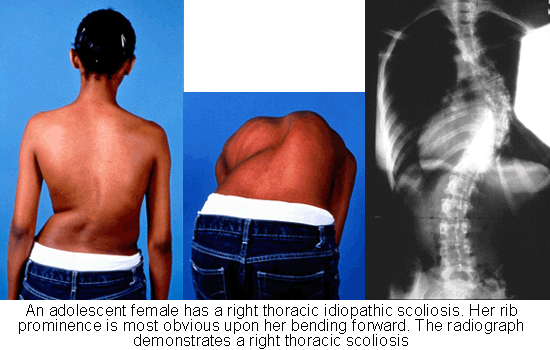Scoliosis in Children and Adolescents
These articles are for general information only and are not medical advice. Full Disclaimer. All articles are compliments of the AAOS

Description
Many schools regularly conduct scoliosis screenings among students. Usually, these screenings occur during the middle school years. If your child receives a referral for scoliosis based on a school screening, here are some facts you should know. Scoliosis:
- Is a sideways curvature of the spine that makes the spine look more like an “S” or “C” than a straight “I”.
- Can cause the bones of the spine to turn (rotate) so that one shoulder, scapula (wingbone), or hip appears higher than the other.
- Can run in families. However, the exact cause of most cases of scoliosis is not known (idiopathic).
- Can occur at any age. Adolescent idiopathic scoliosis occurs after the age of 10. It is the most common type. Infantile scoliosis occurs in children less than 3 years old. It may result from a birth defect, disease of the nerves and muscles (such as muscular dystrophy or cerebral palsy), injury, infection, or tumors. Juvenile scoliosis occurs in children between the ages of 3 and 10 years old. It is not common.
- Does not usually cause any pain.
- Small curves occur with similar frequency in boys and girls, but girls are more likely to have a progressive curve that will require treatment.
Diagnosis of scoliosis:
- Requires a thorough medical history to determine if any other problems may be causing the spine to curve.
- Includes a comprehensive physical examination. The doctor will ask your child to bend forward, which will show any deformities. He or she will also check for any limb-length discrepancies, abdominal muscle strain, or other potential causes.
- Is confirmed with an X-ray of the spine. The physician will measure the degree of the curve as shown on the X-ray. The type of treatment required depends on the kind and degree of the curve, the child’s age, the number of years of growth until the child reaches skeletal maturity and the type of scoliosis.
- If left untreated, scoliosis exceeding 50 degrees can be problematic in the long-term. Progressive deterioration of the curve can occur, which in some cases can lead to diminished lung capacity and the development of restrictive lung disease. Cosmetic concerns are significant to many patients. The incidence of back pain among patients with scoliosis approximates that of the general population.
Treatment Options
Observation
This option is appropriate when the curve is mild (less than 20 degrees) or if the child is near skeletal maturity. However, the doctor will want to recheck the curve on a regular basis to see that it is not progressively getting worse. You may be asked to return every 3 to 6 months for re-examination. Most cases of scoliosis referred through school screening will fall into this category.
Bracing
The goal of bracing is to prevent curves from getting worse. Bracing can be effective if the child is still growing and has a spinal curvature between 25 and 45 degrees. There are several types of braces, most being underarm. Your orthopedist will recommend a brace and tell you how long it should be worn each day. Wearing a brace does not affect participation in sporting activities. Time out of the brace is allowed for these activities.
Treatment Options: Surgical
Surgery
If the curve is more than 45 degrees and the child is still growing, the doctor may recommend surgery. If growth is finished, surgery may still be recommended for curves that exceed 50-55 degrees. Before the operation, your child may be asked to donate blood (which will be used during the surgery as needed). The surgery requires a bone graft from the hip, ribs, or a bone bank. A series of rods, hooks, screws, or wires are used to straighten the spine. Following surgery, patients are walking without a brace by the second or third day, are discharged from the hospital within a week, and can rapidly resume their daily activities. A return to some sports is possible in 6 to 9 months.
